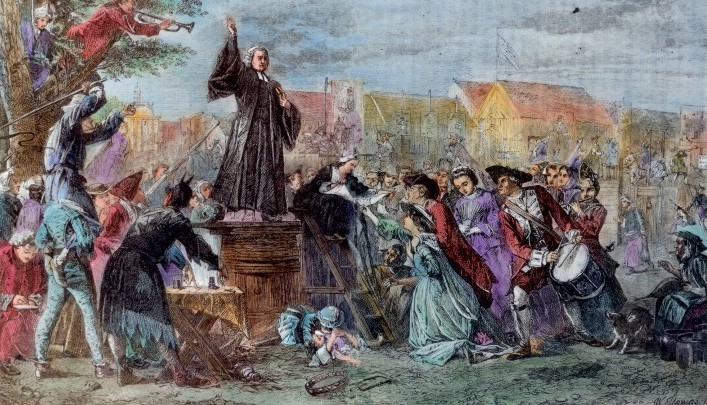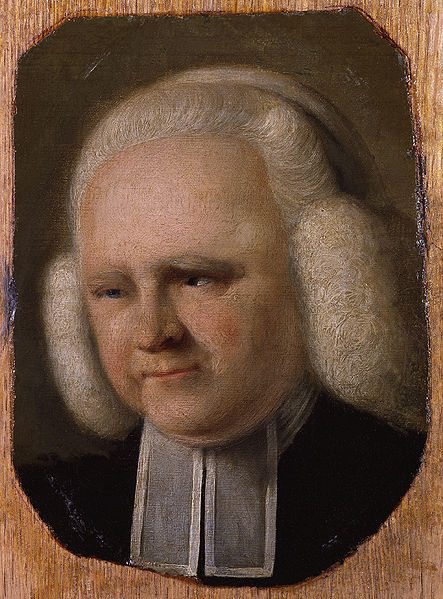George Whitefield and the Holy Club
The Holy Club is a group of Oxford students, led by John Wesley, they seek to make their faith an active part of their daily lives. In contrast to the sinfulness of the early 18th-Century student-life at Oxford, the Holy Club actively pursues a life of prayer, Bible study and moral accountability to God and each other. Their methodical approach to holiness earns them the derisive label of “Methodists.” The Holy Club quickly becomes an important part of an important young man’s life.
One of the members of The Holy Club at Oxford is the dear friend of John and Charles Wesley, George Whitefield.
George Whitefield Overnight Sensation
Upon his graduation from Oxford in 1736, George becomes an overnight sensation. In little more than a year, having been ordained a preaching-deacon of the Church of England, he finds himself preaching to congregations beyond the full capacity of the Anglican Church buildings. This is a unique experience for England, never before had a minister of the Gospel draw such large crowds. The scheduling of additional services to handle the overflow is not enough. Out of necessity, he soon begins to take the pulpit outdoors, into the streets.
What is drawing the masses to hear him? There is nothing spectacular about his appearance. He is slightly overweight. Due to a childhood battle with the measles, one of his eyes is permanently crossed. In addition to these uninspiring characteristics, he is not a tall man, nor one that evokes a sense of leadership.
George Whitefield Criticised by the Media
His nickname, Dr. Squintum, ridicules his physical deformity, given to him by one of his critics who writes and performs a mocking theatrical production burlesquing the cross-eyed preacher. George earns the additional nickname of Dr. Preachfield by another artist who writes a scathing play distorting his childhood exposure to the seamier side of life, suggesting that the women he ministers to are actually his sexual companions and sex-selling employees.
Undoubtedly, what draws people to hear him are unique characteristics attributed solely to George Whitefield. First, he is an unconventional Anglican preacher; contrary to the church’s clergy of the day, he preaches and prays extemporaneously. He feels the approach, without notes, opens his work to the leading of the Holy Spirit. In spite of the undeniable evidence of this, his method opens the door to much criticism from his fellow Anglican clergy and leadership.
Second, and most notably, his admirable theatre influences from childhood surface during his preaching. His audiences, which soon begin to number into the tens of thousands, are compelled by fascination to his sermons richly adorned with theatrical realism as he brings to life the characters of the Bible. One of London’s famous actors, David Garrick, had grown fond of George’s presentations, which often incorporated dancing, crying and screaming. He confesses, ‘I would give a hundred guineas if I could say ‘Oh’ like Mr. Whitefield.’ Garrick continues, ‘He could make one weep by the way in which he pronounces, Mesopotamia.’
Several writers of the day, enamored with George’s incredible gift for oratory, proclaim he preaches like a lion. The estimate is he preaches to over two-million people during the summer of 1739. Many of the day observe his audacious field preaching shaking the very core of stagnant religion in England.
George Whitefield Hands Successful Ministry to John Wesley
Nevertheless, George is not the type to remain in one place for too long. At the height of his fame in England, the twenty-two-year-old George approaches the brothers Wesley. He wants them to continue what God is doing through his preaching, urging them to take the Gospel to the citizens of England via the open field. At first, John and Charles are adamantly against the idea, but they soon agree to accommodate George’s request. This agreement helps George to make peace with his desire, to depart England and launch on his first of several preaching tours in America.
His August, 1739 arrival in Philadelphia coincides with local papers that boast that “no one alive has preached to as many people as George Whitefield, perhaps no one throughout all of history.”



